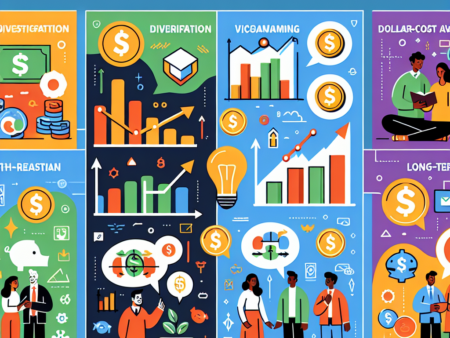Economic Forecasts for Investors: Navigating 2024 Market Trends
As we approach the close of 2024, investors are keenly watching economic forecasts to make informed decisions in an ever-evolving market landscape. Understanding these forecasts is pivotal for strategizing investments, managing risks, and capitalizing on emerging opportunities. In this comprehensive guide, we delve into the key economic indicators, current trends, and actionable insights that can empower investors to navigate the financial markets with confidence.
Why Economic Forecasts Matter for Investors
Economic forecasts provide a glimpse into the future performance of the economy, influencing market sentiment and investment strategies. By analyzing these forecasts, investors can:
- Anticipate market movements
- Identify growth sectors
- Manage portfolio risks
- Optimize asset allocation
Staying informed about economic predictions helps investors make proactive decisions rather than reactive moves, ensuring a strategic approach to wealth management.
Key Economic Indicators to Watch
Several economic indicators play a crucial role in shaping forecasts. Understanding these metrics can provide valuable insights into the market’s direction.
Gross Domestic Product (GDP) Growth
GDP growth measures the overall economic performance of a country. A rising GDP indicates a healthy economy, fostering investor confidence. In 2024, projected GDP growth rates suggest robust economic activity, driven by technological advancements and increased consumer spending.
Unemployment Rates
Low unemployment rates signify a strong labor market, increasing disposable income and consumer spending. As unemployment rates decrease, sectors like retail, real estate, and services are likely to experience growth, presenting lucrative investment opportunities.
Inflation Rates
Inflation affects purchasing power and interest rates. Moderate inflation can stimulate investment by encouraging spending and borrowing. However, high inflation may erode returns and lead to higher interest rates, impacting bond prices and cost of capital for businesses.
Interest Rates
Interest rates, set by central banks, influence borrowing costs and investment returns. In 2024, anticipated interest rate adjustments aim to balance economic growth with inflation control. Investors should monitor rate changes, as they affect stock valuations, bond yields, and real estate investments.
Current Economic Trends in 2024
The economic landscape in 2024 is shaped by several key trends:
Technological Innovation
Advancements in artificial intelligence, renewable energy, and biotechnology are driving growth in these sectors. Investors focusing on tech-driven industries may benefit from substantial returns as these technologies integrate into everyday life and business operations.
Global Trade Dynamics
Shifts in global trade policies and supply chain strategies are impacting international markets. Navigating these changes requires investors to stay informed about geopolitical developments and their effects on various industries.
Sustainability and ESG Investing
Environmental, Social, and Governance (ESG) factors are increasingly influencing investment decisions. Companies with strong ESG credentials are attracting more investments, reflecting a growing preference for sustainable and responsible business practices.
Actionable Insights for Investors
Leveraging economic forecasts can enhance investment strategies. Here are some actionable tips:
Diversify Your Portfolio
Diversification helps mitigate risks associated with economic volatility. Spread investments across different asset classes, sectors, and geographical regions to balance potential returns and losses.
Focus on Growth Sectors
Identify and invest in sectors poised for growth based on current economic forecasts. Technology, healthcare, and green energy are sectors likely to offer substantial returns in the coming years.
Monitor Inflation and Interest Rates
Stay updated on inflation trends and central bank policies. Adjust your investment portfolio to hedge against inflation by incorporating assets like real estate, commodities, or inflation-protected securities.
Utilize Technical and Fundamental Analysis
Combine technical analysis, which examines price movements and market trends, with fundamental analysis that evaluates a company’s financial health. This dual approach can provide a comprehensive understanding of investment opportunities.
Risk Management Strategies
Effective risk management is essential for safeguarding investments against unforeseen economic shifts:
Set Clear Investment Goals
Define your financial objectives, risk tolerance, and investment horizon. Clear goals help in crafting a tailored investment strategy aligned with your personal financial situation.
Implement Stop-Loss Orders
Stop-loss orders automatically sell a security when it reaches a certain price, preventing significant losses in volatile markets. This tool is particularly useful in managing downside risk.
Stay Informed and Adaptable
Regularly review economic forecasts and market news. Being adaptable allows you to adjust your investment strategy in response to changing economic conditions.
Conclusion
Economic forecasts are invaluable for investors seeking to navigate the complexities of the financial markets. By understanding key economic indicators, staying abreast of current trends, and implementing strategic investment and risk management practices, investors can make informed decisions that enhance their financial growth and stability. As we move through 2024, staying informed and adaptable remains paramount in achieving investment success.
Frequently Asked Questions
- What are the most important economic indicators for investors?
- The most important economic indicators include GDP growth, unemployment rates, inflation rates, and interest rates. These metrics provide insights into the overall health of the economy and influence investment strategies.
- How can investors use economic forecasts in their investment decisions?
- Investors can use economic forecasts to anticipate market movements, identify growth sectors, manage risks, and optimize their asset allocation. This proactive approach helps in making informed and strategic investment choices.
- What sectors are expected to grow in 2024 based on current economic forecasts?
- Based on current economic forecasts, sectors such as technology, healthcare, renewable energy, and ESG-focused industries are expected to experience significant growth in 2024.
- How do interest rates affect investment portfolios?
- Interest rates influence borrowing costs, consumer spending, and business investment. Rising interest rates can lead to higher bond yields and impact stock valuations, while lowering rates may stimulate economic growth and increase equity prices.
- What risk management strategies should investors implement?
- Investors should set clear investment goals, diversify their portfolios, use stop-loss orders, and stay informed about economic trends. These strategies help in mitigating risks and protecting investments against market volatility.
Disclaimer
The information provided in this article is for informational purposes only and should not be construed as financial or investment advice. It is always recommended to conduct thorough research and consult with a professional advisor before making any investment decisions.


















